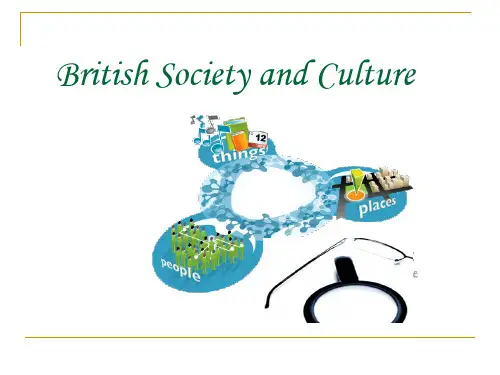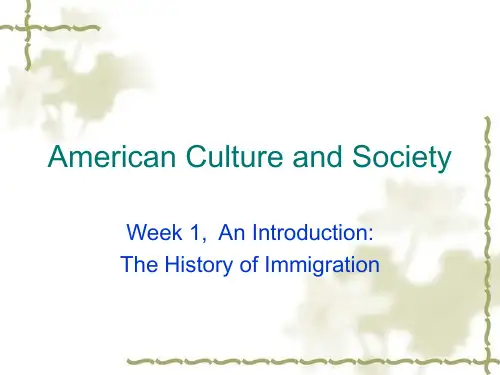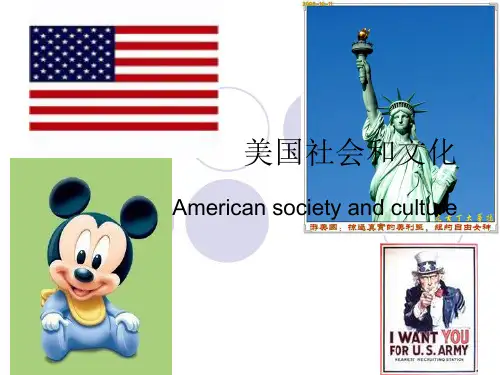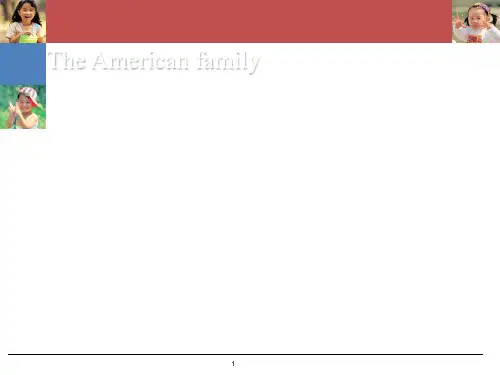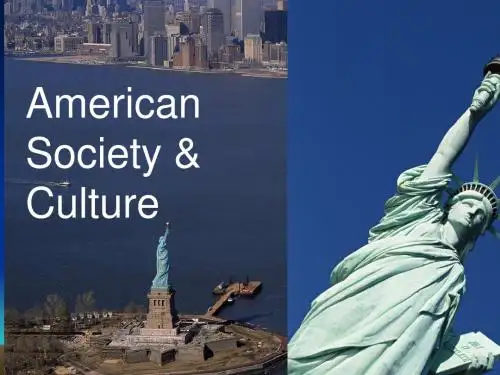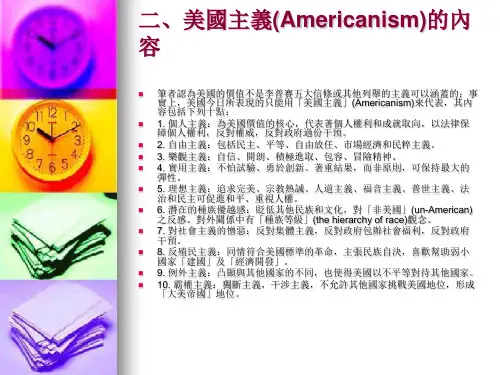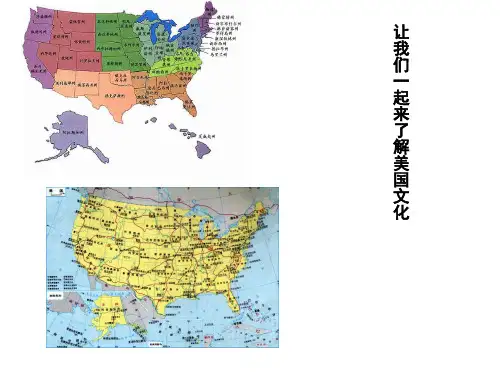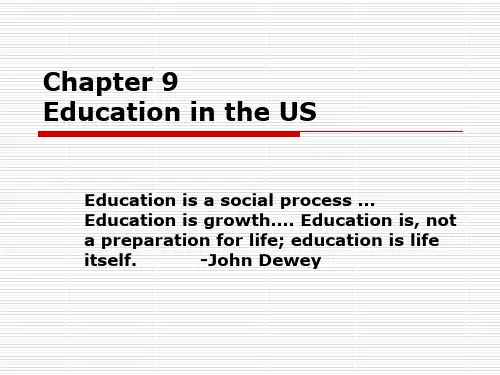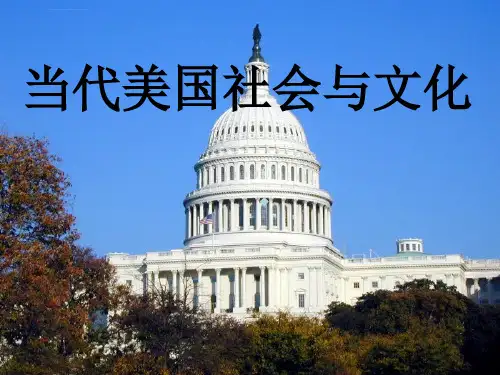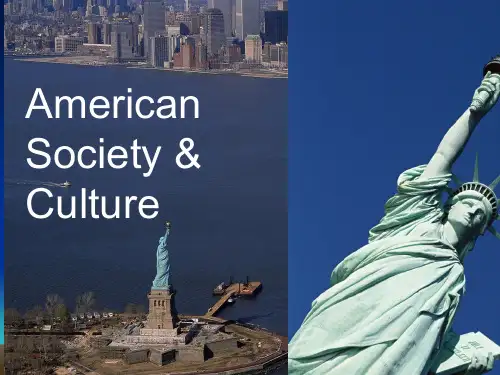清华大学美国社会与文化课件American Families_304709025
- 格式:ppt
- 大小:534.50 KB
- 文档页数:30
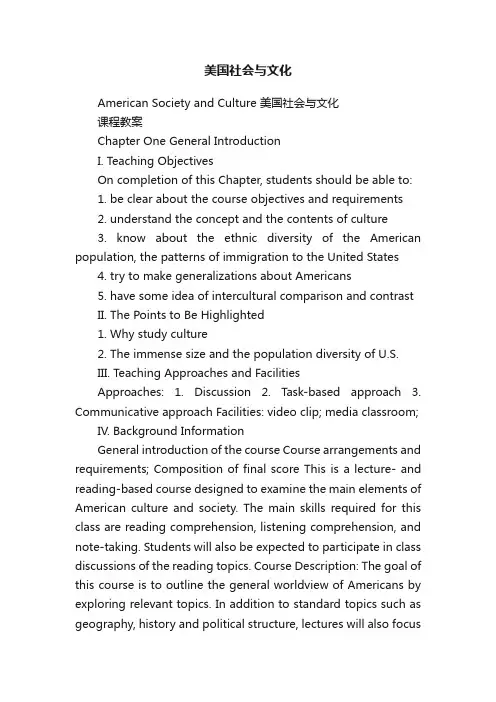
美国社会与文化American Society and Culture 美国社会与文化课程教案Chapter One General IntroductionI. Teaching ObjectivesOn completion of this Chapter, students should be able to:1. be clear about the course objectives and requirements2. understand the concept and the contents of culture3. know about the ethnic diversity of the American population, the patterns of immigration to the United States4. try to make generalizations about Americans5. have some idea of intercultural comparison and contrastII. The Points to Be Highlighted1. Why study culture2. The immense size and the population diversity of U.S.III. Teaching Approaches and FacilitiesApproaches: 1. Discussion 2. Task-based approach 3. Communicative approach Facilities: video clip; media classroom;IV. Background InformationGeneral introduction of the course Course arrangements and requirements; Composition of final score This is a lecture- and reading-based course designed to examine the main elements of American culture and society. The main skills required for this class are reading comprehension, listening comprehension, and note-taking. Students will also be expected to participate in class discussions of the reading topics. Course Description: The goal of this course is to outline the general worldview of Americans by exploring relevant topics. In addition to standard topics such as geography, history and political structure, lectures will also focuson traditional values, ethnic diversity and assimilation, and modern social problems of American society. Students will have a weekly reading assignment and are expected to come to class ready to discuss the content of the readings. The lectures will clarify and expand upon the reading material, and students are expected to take careful notes during eachlecture. In addition, selected films relating to various reading assignments will help to illustrate relevant topics and concepts concerning contemporary American life. Students are responsible for viewing the films, as well as relating the themes to class content. As society cannot be defined without mentioning ―people,‖ great attention will be paid to the most common aspects of life in America. Although such topics as geography and history are important to the shaping of any society, the most time will be spent discussing the society as it exists today, how citizens exist within the society, and how they relate to the rest of the world. Course Objectives: At the end of the term, students will be able to: 1) Name and describe the distinguishing features of American society and culture 2) Describe how geography and history have helped shape these features 3) Summarize common characteristics, daily lives, and social habits of American citizens 4) Discuss the social problems facing America, placing emphasis on causes and possible solutionsV. Teaching Procedures and Contents1. Lead-inQuestions: Why do you choose this course and what do you expect to learn? What do you know about America and Americans? OR People are naturally curious about each other, and when they meet people from different countries, they wantto know about them: What is life like in their country? What kind of houses do they live in? What kind of food do they eat? What are their customs? If we visit their country, we can observe the people and how they live, and we can answer some of these questions. But the most interesting questions are often the hardest to answer: What do the people believe in? What do they value most in life? What motivates them? Why do they behave the way they do?2. Specific Contents(1)Discuss the definition and contents of culture (2)Name the visible and invisible aspects and culture(3)Question: What do you know about the ethnic diversity of the American population? Where did the people originally come from? How have patterns of immigration to the United States changed over the years? Do you think it is possibleto make generalization about Americans? (4) Give the answers and explain, illustrate the main contents with ppt the United States as a nation of immigrants cultural pluralism in the United states generalizations about American beliefs3. Task designGroup discussion: why do we study culture? Questions for students: Before you read the chapter, think about what you know about the culture of a country. Provide the students with some new terms and help them to translate.4. Practical ExercisesQuestions for intercultural study and discussion (1)What effect does the geography of a country have on its people? Does our country have different climates? What effect does climate have on the lifestyles of the people in our country? How is life in a small country different from life in a large one? (2)Whatdifferent ethnic groups are there in your country? Where do they live? How are they different from the majority of people in your country: language? clothing? food? music? customs? What effect do different ethnic groups have on a country? (3)What is your country?s policy on immigration? Are there quotas for how many people are allowed to come from each country? Can immigrants become citizens? Are there ―guest workers‖(people who work there temporarily) in your country? How do people in your country feel about foreigners?(4)Do you think it is possible to describe the average person in your country? Do you think people all over the world are basically the same or basically very different? How are Americans different form people in your country?VI. AssignmentsPre-read the first part of the given materials, American Beginnings, get preparedfor the next lesson.VII. Reference Material《美国文化背景》世界图书出版公司Page 4- Page 8Chapter Two History I American BeginningsI. Teaching ObjectivesOn completion of this Chapter, students should be able to:1. know and remember the discovery of America2. know and can analyze three profound changes in the 16th and 17th century3. know about the the ancient civilizations of America4. understand the Catholic, protestant and puritan and their settlements in north AmericaII. The Points to Be Highlighted1. Religious Reformation in the 16th and 17th century2. Early settlements3. The influence of Puritanism on American cultureIII. Teaching Approaches and FacilitiesApproaches: 1. Pair/Group work 2. Discussion 3. Questions and answers… Facilities: media classroom;IV. Background InformationThe American RevolutionThe American Revolution, also known as the revolutionary war, was one of the most significant events in American history. Without it, the United States of America may not have come into existence. Read on and learn why it happened, and learn about key events of the revolution. Also check out our links to other sites on the American Revolution.Years: Pre-1775French and Indian WarQuest for Independence Lack of Government Representation The Stamp Act The Townsend Act The Boston Massacre The Gaspee Incident The Tea Act The Intolerable Acts 1756-1763 1764- 1765 1767 1770 1772 1773 1774TaxationTownsend Act is repealed The Boston Tea PartyFirst Continental Congress Years: 1775 to 1777Battle of Lexington and Concord Battle of Bunker HillBritish Evacuation of Boston Declaration of IndependenceWashington crossing the Delaware Battle of Princeton Battle of Germantown Battle of Bennington Winter at Valley Forge 1775 1776 1777Second Continental Congress, Capture of Fort Ticonderoga Battle of Quebec Battle of Long Island, Battle of White Plains Battle of Fort Washington Battle of TrentonBattle of Brandywine Battle of OriskanyBattle of Saratoga (Surrender of Burgoyne) Years: 1778 to 1789France enters the war Battle of Savannah Battle of Charleston Battle of King's Mountain Battle of Cowpens Battle of Eutaw SpringsArticles of Confederation Treaty of Paris ratified ending the warConstitutional ConventionGeorge Washington elected first President of United States 1778 1779 1780 1781 1782 1783 1787 1789Battle of Monmouth Spain enters the war Battle of Camden Battle of Guilford Battle of Yorktown Treaty of Paris signed The Star-Spangled BannerOh, say can you see, by the dawn's early light What so proudly we hailed by the twilight's last gleaming Whose broad stripes and bright stars, through the perilous fight, O'er the ramparts we watched were so gallantly streaming And the rockets red glare, the bombs bursting in air Gave proof through the night that our flag was still there Oh, say does that star-spangled banner yet wave O'er the land of the free, and the home of the brave. 美国国歌《星条旗永不落》("the star-spangled banner"曾译《星条旗》歌在晨曦初现时,你可看见是什么让我们如此骄傲?在黎明的最后一道曙光中欢呼,是谁的旗帜在激战中始终高扬!烈火熊熊,炮声隆隆,我们看到要塞上那面英勇的旗帜在黑暗过后依然耸立!啊!你说那星条旗是否会静止,在自由的土地上飘舞,在勇者的家园上飞扬?V. Teaching Procedures and Contents1. Lead-inWhy study history? Compared with Chinese history, what do you about American history?2. Specific Contents(1) Overview: A good knowledge of the past is essential to understanding the present as well as the future. Students need to appreciate that the present comes from people and events from the past and that history is a chronological record. To be responsible citizens in the world today and tomorrow, students need to comprehend the historical concepts of time and chronology, cause and effect, continuity and change, major historical events and periods, and the impact of religion, philosophy, and other major belief systems on history.The purpose of this lesson is to review the important historical events and time periods of United States history from discovery to the present. Through the use of art, crafts, drama, music, and dance, students can acquire a better understanding of the important contributions of individuals as well as cultural groups, and their impact on U.S. history. This lesson is used to culminate all the units studied during the semester.(2) Teacher‘s lecture I. The first settlements in early historyi. The Land Bridge –Bering Strait. The first people to live in North America came from Asia between 10,000 and 30,000 years ago. At that time, North America and Asia were connected by a land bridge.. These people may have been following herds of buffalo or woolly mammoths. They eventually spread throughout Canada and the United States.ii. Indian Nations and Tribes. Eventually North America became populated by many different tribes of people. These tribes lived in most areas of the country, adapting to the local land and climate. . Many lived in mountainous regions, others on plains. They hunted, fished, andwhere soil permitted they planted crops and farmed the land.iii. Three Great Civilizations. Aztec . Incas . MayaII. Discovery of New Land i. background ii. Christopher Columbus III. Europe in the 16th and 17th Centuriesi. backgroundii. Dramatic changesiii. Protest an and Puritaniv. The Pilgrims settlementIV. North American coloniesV. The American RevolutionSee some excerpts of the movie The declaration of independence3. Task designAsk the students to sum up the test after reading Ask some students to talk about the origin of Thanksgiving Day Ask the students to talk about their knowledge about Christopher Clumbers Ask the students list some important events in American Revolution.4. Practical Exercises(1) Students will write and illustrate a time line depicting major time periods or interesting facts. They can work in groups or independently to make single panels for a time line or use butcher paper to make longer ones. (2) Students can pick an area of interest and write and/or act out a role-play(Abraham Lincoln) or read a speech. /The teacher can play them some records of famous speeches(Ex. Gettysburg Address). (3) Listen to a song, identify and learn to sing it.VI. AssignmentsFinish the Exercises on pp 48-51. Preread the following partVII. Reference Material1./doc/3616190118.html,2.The Society and Culture of Major English-speaking countries An IntroductionChapter Three History II U.S.A. – a new nationI. Teaching ObjectivesOn completion of this Chapter, students should be able to:1. know The French and Indian War (1754-1763)2. master Missions of California (1769-1834)3. The Louisiana Purchase4. The War of 18125. The Civil war6. The California Gold Rush (1848 to 1859)II. The Points to Be Highlighted1. The French and Indian War (1754-1763)2. The Civil warIII. Teaching Approaches and FacilitiesApproaches: 1. Task-based approach 2. Communicative approach 3. Questions and answers…… Facilitie s: media classroom;IV. Background Information1.The Louisiana PurchaseWhat was it? In 1803, the United States bought the Louisiana Territory from France. James Madison, the U.S. Secretary of State, paid 15 million dollars for the land. The Louisiana Territory included much of what is now central United States. It stretched from New Orleans in the south to the Canadian border in the north. And it stretched from the the Mississippi River on the east to the Rocky Mountains on the West.2. The War of 1812Why it Started? Both Britain and France were interfering with American trade and were taking American ships.The United States believed that Britain still not treating it as an independent country, and was actually providing Native Americans with guns to attack American settlers.The United States also wanted to take Canada from Britain, and Florida from Spain.These ongoing disputes led to the War of 1812. The War The United States attempted to invade Canada, but failed. The British captured and burned Washington, D.C.. The British also attempted to invade the United States from Canada, but failed.This picture shows Captain Oliver Perry's victory at the Battle of Lake Erie (Source: Library of Congress). Commander Andrew Jackson defeated the British when they tried to invade New Orleans.The End A peace treaty was finally signed in December of 1814. The British agreed to recognize the United States country boundaries. In addition, the United States had established itself as a powerful military force. 3. Events of the California Gold Rush James Marshall discovers gold at Sutter's sawmillGold Rush starts to attract people from around the worldCalifornia becomes a stateGold becomes more scarce Development of better mining techniquesPopulation of California exceeds 300,000Sacramento becomes the California State CapitalDiscovery of silver in Nevada ends the California Gold Rush 1848 1849 1850 1852 1853 1855 18594. The Civil WarThe Civil War split the nation. It was the most bitter conflict within the United States. The source of the conflict between theNorth and the South resulted from fundamentally different ways of life. Economy in the South was heavily based on agriculture and growing cotton. The North was heavily industrialized with factories and manufacturing being central to the economy. Growing and harvesting cotton required large numbers of workers. This work force was made up of about 4 million slaves. By the 1800's, the African slave trade had become illegal. But existing slaves were not freed. Men and women of the North pushed to completely abolish slavery. The South feared that losing the slaves would have a severe economic impact on cotton plantations. Abraham Lincoln was against slavery. When he was elected President in 1860, seven Southern states left, or seceded, from the United States. They formed the Confederate States of America. On April 12, 1861, southern Confederate forces captured Fort Sumter in South Carolina. Four more states seceded, and the Civil War began. The Civil War consisted of more than 50 major battles and 5000 minor battles. In less than 5 years, more than 600,000 men were killed and hundredsof thousands of others were wounded. The Union army with more soldier and resources eventually overcame the Confederate army. On April 9, 1865, General Lee surrendered his Confederate troops. The war was over. Five days after the surrender treaty was signed, President Abraham Lincoln was assassinated by a Southern sympathizer.Civil War TimelineThe following time line shows major events of the Civil War. Click on any of the events for more detail.Slavery Lincoln Elected The South Secedes Battle of Bull Run The War Order Emancipation ProclamationSurrender General Lee's Confederate TroopsAssassination of President LincolnFinal surrender of the Confederate armyPre-1861 Mar. 1861 Jan. 1861 July 1861 Jan. 1862 Jan. 1863 April 9, 1865 April 14, 1865 May 4, 18655.The Mexican War (1846-1848) Events Leading to the Mexican War The United States and Mexico disagreed over the border between the countries. Mexico never recognized Texas as a separate territory, and the United States wanted Texas as a U.S. territory. In May, 1846, the United States declared war on Mexico. Through the Mexican War, the United States expanded its territory to the south, and all the way to the west coast of California. The WarThe United States armies led by General Zachary Taylor, General Winfield Scott and Captain Fremont eventually defeated the Mexican army led by Antonio Lopez de Santa Anna. The Result As a result of the war, Mexico agreed to the Rio Grande River as the boundary between T exas and Mexico. Mexico also gave the United States the land consisting of California, Nevada, Utah and part of Arizona.6. The Moon LandingA race was on to put a man on the moon. President Kennedy had challenged the nation. It was the mission of Apollo 11 to land two men on the moon, then return them safely to Earth. It was one of the most historic events. It demonstrated what man can do with effort and ingenuityV. Teaching Procedures and Contents1. Lead-inAn American Superstition2. Specific ContentsTeacher‘s lecture and slide show of the following historicalevents The French and Indian War (1754-1763) Missions of California (1769-1834) The Louisiana Purchase The Louisiana Purchase helped the United States open up the country. The War of 1812Although the United States had become an independent country, it still had not established itself with the other world powers. The California Gold Rush (1848 to 1859) The Gold Rush was one of the most significant events in California history. It brought people from all over the United States and the world in search for gold. The Civil war The Mexican War (1846-1848) The United States and Mexico disagreed over the border between the countries. Mexico never recognized T exas as a separate territory, and the United States wanted Texas as a U.S. territory. In May, 1846, the United States declared war on Mexico. The Mexican War U.S. in the two world wars 3. Task designThe students are supposed to make a presentation with PPT on the subject of American Independence War. Some students are supposed to discuss in group: What are the factors that may lead to a war?4. Practical Exercises(1)discuss some of the social, political, and personal issues that Americans confronted during the Civil War era. (2)use the Internet to locate resources related to the Civil War and incorporate information from these resources into their own writing.(3)define historical fiction and identify some of the techniques writers use to create good historical fiction.(4)discuss the central issues of the Civil War from a variety of different perspectives.(5)share their personal reactions to what they have learnedin both small-group and whole-class discussionsVI. AssignmentsThe Civil War era is one of the most critical and fascinating in American history. The many books about this period written for young audiences provide a rich context in which to learn about the Civil War itself and to explore more basic issues about the nature of human life and society. Read to accomplish the practical exercisesVII. Reference Material1./doc/3616190118.html, 2./doc/3616190118.html,3./doc/3616190118.html,Chapter Four The Political System in the United StatesI. Teaching ObjectivesOn completion of this Chapter, students should be able to:1. know about the Articles of Confederation and the American Constitution2. the American political systemII. The Points to Be Highlighted1. checks and balances2. Bill of RightsIII. Teaching Approaches and FacilitiesApproaches: 1. Discussion 2. Task-based approach 3. Questions and answers Facilities: video clip; media classroom;IV. Background InformationOrigins After years of struggle and numerous battles in the late 1700s, the United States finally succeeded in breaking from the British Empire and became the first colonial possession to achieve independence from the mother country. Separation from England created an immediate problem to the newly born nation.Thai is, once the break was made, what was to be the legal basis for government? T o put it in another way, by what right would government govern? We know that, before the American Revolution, the source of political authority had rested in allegiance to the monarch in England. Now, with that allegiance no longer in existence, what source could the new nation draw on for its legitimacy? This juridical dilemma was solved by fifty-five men. who, in the summer of 1787, gathered in the city of Philadelphia to draw up the Constitution of the United States of America.The document they created begins with a memorable phrase: "We, the people of the United States," thus launching a nation rooted in the supreme authority of "the people". But, of course, the fifty-five delegates were being somewhat presumptuous, because although they assumed the right to speak for the people, they, in fact, were representatives of only a small elite group within the total population. They were, for example, male, white, and from the upper-middle or upper class. Half of them were college graduates. Many, like Alexander Hamilton, James Madison, and Benjamin Franklin, were intellectuals. Could they really speak for black slaves, for women, for the illiterate poor, and for the Native Americans, who, by all measures, had every right to affirm that they were really ''the people"? However, despite the lack of prophetic power, those now-sanctified Founding Fathers of 1787 did draw up a constitution, under which a new nation was officially brought into existence on the face of earth.V. Teaching Procedures and Contents1. Lead-inWhat do you know about the Chinese democracy? Talk aboutthe political system of China.2. Specific ContentsTeacher‘s Lecturei.the Articles of Confederation(联邦条款)After the War of Independence was won, the new nation of the United States was organized under the agreement of the Articles of Confederation with a weak national government called the Congress. Each state had its own government, made its own laws and handled its internal affairs. The states did not cooperate with the Congress and with each other. The Congress had no power to force any state to contribute money to the national government and the Congress could not tax any citizen either. As a result, the Articles of Confederation failed.ii.the making of the U.S ConstitutionThe Articles of Confederation failed. The Congress decided to hold a constitutional convention to revise the Articles of Confederation. The delegates from 12 states (Rhode Island refused to participated) gathered in Philadelphia in 1787 and end up in writing a new constitution and set a federal system with a strong central government. The Constitution provided that an election of the president would be called for, federal laws would be made only by a Congress made up of the House of Representatives and the Senate and a Supreme Court would be set up. This new Constitution was finally approved by the majority of the citizens in over 9 of the 13 states and was officially put into effect in 1787 ) * A federal system is one in which power is shared between a central authority and its constituent parts, with some rights reserved to each. * to protect citizens from tyranny, a ―Bill of Rights‖ was added to the Constitution in 1791.iii.the 3 branches of the U.S federal government--- the legislative branch is made up of elected representatives from all of the states and is the only branch that can make federal laws, levy federal taxes and declare war or put foreign treaties into effect. It consists of a Congress that is divided into the House of Representative and theSenate. The House of Representatives has 435 members who serve two-year terms. The Senate comprises 100 lawmakers who serve six-year terms. Each state, regardless of population, has two senators. --- the executive branch is the president, who is elected to a four-year term. A president can be elected to only two terms according to an amendment passed in 1951. The president can appoint federal judges as vacancies occur. He is the commander in chief of the armed forces. The president has other broad authorities in running the government departments and handling foreign relations. --- the judicial branch is headed by the Supreme Court with a chief justice and 8 associate justices. The Federal courts have jurisdiction over cases arising out of the Constitution and other cases which do not arise out of individual states. The Supreme Court has the judicial review power, the power determining whether congressional legislation or executive action violates the Constitution. * Systemof ―checks and balances (制约与平衡的原则)‖of the three-part national government works to keep serious mistakes from being made by one branch or another.iv.the Bill of Rights (another basic foundation in the U.S Constitution )--- consists of the first 10 amendments which were added to the Constitution in 1791. The Bill of Rights was passed to guarantee freedom and individual rights such as freedom of speech, the right to assemble in public places, the right to ownweapons and so on. * There were 16 other amendments to the Constitution as of 1991. So, there are 26 amendments to the U.S Constitution.v.Two major Political Parties--- the Democratic Party, which is thought to be more liberal and the symbol of which is the donkey (Under President Franklin Roosevelt?s ―New Deal‖, Democrats set up government programs that provided paid employment for people building dams and roads and public buildings and Social Security社会保障制度, which ensures that those who are retired or disabled receive monthly payments from the government ) --- the Republican Party, which is believed to be more conservative and the symbol of which is the elephant.(Republicans place more emphasis on private enterprise and often accuse the Democrats of making the government too expensive and of creating too many laws that harm individual initiative.)* Americans do not have to join a political party in order to vote or to be a candidate for public office. However, running for office without the money and campaign workers a party can provide is difficult (若没有钱和政党所能提供的选举活动者们,想要竞选职位是很难的)3. Task designAsk the students to sum up the text main points after reading Ask the students to debate in a group of four people about the truth of American Democracy.4. Practical ExercisesOral Report: The U. S. Constitution begins with a memorable phrase: "We, the people of the United States/' thus launching a nation "of the people, by the people, and for the people." On what grounds could the delegates to the ConstitutionalConvention of1787 make such a sweeping statement that they represented the people of the United States of America?VI. AssignmentsThink about the questions in Practical exercises. Finish the after-reading exercises on pp 62-64VII. ReferenceChapter Five American EconomyI. Teaching ObjectivesOn completion of this Chapter, students should be able to:1. understand the root of American affluence2. know service industry3. know American industry4. the basic information about free enterpriseII. The Points to Be Highlighted1. the root of American affluence2. free enterpriseIII. Teaching Approaches and FacilitiesApproaches: 1. Pair/Group work 2. Discussion 3 Task-based approach Facilities: media classroom;IV. Background InformationFrom Producers to Consumers.During most of US History, Americans have seen themselves as great producers–Agriculture and Domestic goods–Manufactured goods.This began to change with the advent of radio and television –Commercials–The drive to consumeTelevision。
